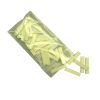YSI 6130 Rhodamine WT Sensor
Features
- Temperature compensation provides greater accuracy
- Turbidity and chlorophyll fluorescence rejection helps eliminate interferences
- Wiped optics field-proven for fouling prevention
- Expedited repair and warranty service
- Lifetime technical support
- More
Overview
The YSI 6130 sensor provides an accurate, in-situ measurements of Rhodamine WT in fresh, brackish, seawater, stormwater and wastewater. The 6130 is a fouling-resistant, wiped sensor designed to seamlessly integrate with all YSI sondes that contain an optical port without the need for external interface hardware.
Accuracy
The YSI 6130 Rhodamine WT Sensor rejects turbidity and chlorophyll interference. Measurement accuracy is further enhanced through correction for the effects of temperature.
Applications
The YSI 6130 sensor can be used in combination with those YSI sondes that have optical ports - 600 OMS, 6820, 6920, 6600, 6820 V2, 6920 V2, or 6600 V2 - and a YSI 650 MDS handheld display-logger. Make surface as well as vertical profile measurements. In addition, the YSI 6130 in combination with one of the YSI data logging sondes can be used for unattended continuous monitoring or integrated with data collection platforms for real-time data acquisition.
- Range: 0-200 ug/L
- Resolution: 0.1 ug/L
- Accuracy: +/-5% reading or 1 ug/L, whichever is greater
- Warranty: 2 years
In The News
Rhodamine Dye Tracer Systems
Until the advent of in situ rhodamine WT measurement systems, dye fluorometry hydrologic measurements were performed by the analysis of multiple samples physically extracted from the water body as the dye plume was naturally dispersed. Most of these investigations are performed using fluorometers designed for in vitro and pump-through measurements. Although these methods can produce accurate hydrologic data, they are resource-intensive, significantly vulnerable to human error and other natural phenomenon. They also necessitate the field deployment of personnel throughout the duration of the study. The recent employment of in situ measurement systems has accentuated the limitations of in vitro and pump-through methods for performing these studies.
Read MoreStone Lab: Cyanobacteria Monitoring in Ohio Lakes
Microcystin, one of several toxins produced by the cyanobacteria that form harmful algal blooms (HABs), has become a popular topic of lake research as the human health impacts of HABs become better understood. Stone Lab is one of the leading groups in algal bloom research on Lake Erie and other lakes in Ohio. For more than 100 years, Stone Lab has conducted biology research and provided science education and outreach to the region. Over the years, thousands of individuals of varying ages have learned from the resources Stone Lab provides. Stone Lab’s Research Coordinator and Senior Researcher, Justin Chaffin, learned of Stone Lab while an undergraduate student at Bowling Green State University Fireland Campus.
Read MoreFrom Assessment to Angler: Continual Research Ensures Lake Erie Remains a Beacon of Freshwater Fishing
Lake Erie is well known for its abundant recreational fishing. Anglers come from across the country to try their luck at the “walleye capital of the world” and search for other freshwater species, such as bass, perch, and steelhead trout. As one of the world’s largest freshwater fisheries, much effort is made behind the scenes to maintain fishing opportunities for visitors to enjoy year after year, efforts that often go unnoticed by the public. One of the lake's most important economic and tourism centers is the city of Sandusky, home to the Sandusky Fisheries Research Station . As part of the Ohio Division of Wildlife, the unit serves as a base for assessing fish populations and managing harvest with partner agencies from around Lake Erie.
Read More












